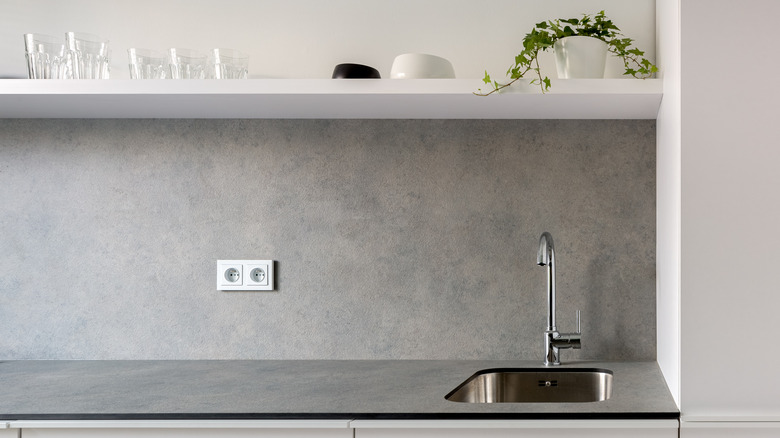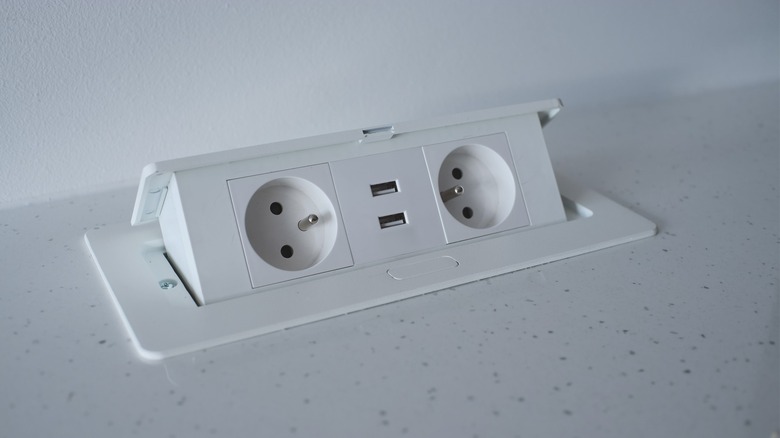Why You Should Consider Hidden Kitchen Outlets For Your Next Reno
Integrated kitchens are becoming increasingly mainstream, where the new trend is to make the room feel less like a workspace and more like another stylish part of the house. Fridges and dishwashers are hidden behind panels, while stovetops and ovens are embedded into the cabinetry, lessening their appearance. We're also beginning to hide all of our small gadgets such as air fryers and microwaves to keep the room from looking cluttered. "Butler's pantries and appliance garages are also becoming increasingly popular, which allow the countertop to remain clear," interior designer Audrey Scheck told Forbes. The most coveted kitchen is the one that doesn't look like a kitchen at all. And if you go to the trouble of hiding all of those appliances, then you also want to invest in hidden kitchen outlets. You don't want a stark white cover ruining your sleek and sophisticated design.
This genius electrical outlet tip is especially important if you invested in a showstopping backsplash. Whether you opted for a marble slab or sourced unique tiles, you don't want an outlet throwing a wrench in the elevated design. But a kitchen needs outlets — and plenty of them. So a workaround to this is to have them hidden, and there are several ways to go about this. The easiest is to have an electrician hide a power strip under your cabinet uppers, effectively concealing them. However, you can also choose pop-up outlets and specialty finish outlets. Let's take a look.
Add a power strip under your upper cabinets
The easiest way to hide your outlets is to have an electrician install a power strip underneath your uppers. This will not only give you a decent amount of outlets (perfect for all of those small kitchen appliances!), but it will also seamlessly hide them. This allows you to have a clean and clutter-free backsplash. It will also keep cords in order in your kitchen since these power strips aren't practical for having gadgets permanently out on your counters. Legrand's Plumgold systems is a trusted brand on the market, and you can choose the length, color, and voltage that works best for your project. For example, the Wiremold system is available in either 3- or 5-foot long power strips, allowing you to choose the one that best fits your upper layout.
The cost of these strips varies depending on which brand you get and how long the strip is. For example, the 3-foot Wiremold strip is an affordable $55 at Lowe's. It has six outlets which are spaced 6 inches apart. However, DirectCabinet's patented Slim Angle Power Strip is just 2-feet long with four outlets, but it's $263. This could be worth the price for some due to the fact that it's angled, making it more convenient to plug in and unplug appliances. You will have to choose a strip that works best with your needs and budget.
You can also try pop out and specialty finish outlets
If you don't have upper cabinets — or you want to add outlets to your island — then a pop out outlet might work better for your situation. These outlets are also hidden, but they're stowed on a countertop rather than underneath an upper. To use them, you press down on the camouflaged cover and the outlet pops up. Once you're done using them, you press them back down into the surface. You can get these from vendors like KitchenPowerPopUps.com and PopUpOutlets.com and can choose different colors, shapes, voltages, and mounting styles (such as flush or surface). These typically cost between $175 to $300 per outlet.
If you want to avoid drilling into your countertops but don't have uppers, then you can also try a specialty finish outlet. This is when the outlet cover is custom made to match the surrounding backsplash, so all you see is the nondescript outlet holes. Companies like Trufig create custom flush-mount covers to match the marble, granite, wood, or tile you are using in your kitchen. But as you can imagine, the custom price has a hefty price tag, $400 or more. You will also need to hire a contractor to create the rough-in for the Trufig outlet mounting platform and box before the drywall goes up as well as an electrician to install it, which will raise the price even further.

